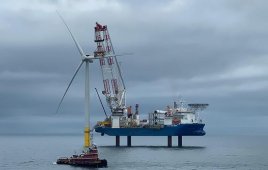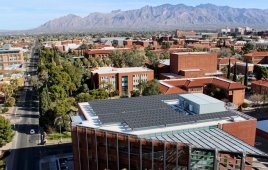Greg Alverez / AWEA
We’ve rounded up the top five facts that can better inform all candidates about the reality of this popular, homegrown source of electricity.
1. Wind is already cheaper than fossil fuels in wind-rich areas such as Iowa and Texas, a statement Politifact checked and rated “True.” It’s increasingly cost-competitive, not counting any incentives. The price utilities pay for new wind energy has fallen 66% since 2009, with savings passed directly to homeowners and businesses on their electric bills. That’s a big reason why wind was the largest source of new electric generating capacity last year, and Fortune 500 companies are saying that buying wind saves them money. (Editor’s note: First Energy is charging customers about 1 cent/kWh more for wind generated power.)
2. Wind is mainstream now and contributes to a reliable grid. Wind reliably generates over a third of Iowa’s electricity year-around, for example, and over 10 percent in Texas. In Colorado, wind now peaks at over 60% of all the electricity used by the state.
3. Wind energy has the lowest impacts on wildlife of any way to make large amounts of electricity. According to government statistics, a typical American wind turbine would be struck by less than one bird per month on average. Wind energy makes up one-hundredth of one percent of all human impacts on birds, and unlike all the others is working hard to offset those impacts so that eagles and all birds are better off because of what we do. Climate change is a far greater threat to all birds, And wind energy is the biggest, fastest, cheapest solution we have today, short of not using energy. “Wind turbines are way at the end of the list of threats to birds compared to fossil fuel development, oil pits, coal mining — and collisions with buildings,” according to Nicolas Gonzalez, an Audubon Society spokesman.
4. Modern wind turbines can coexist well with eagles, too. Based on best available data, wind power is responsible for less than 3% of all human-related golden eagle losses. A large percentage of wind energy’s impacts on eagles has historically occurred at a limited number of wind farms in California, which were constructed more than 30 years ago. These are some of the nation’s oldest wind installations, and were built long before the relationship between wind and eagles was fully understood – relying on limited siting practices and utilizing technology that created greater risk than the modern wind farms of today.
Throughout the rest of the country, where more modern machinery and better siting practices have been utilized, impacts to individual eagles are a much rarer event.
Cases of bald eagles striking turbines are even rarer.
5. Over 60% of the value of a U.S. wind farm is U.S.-made. The leading suppliers of wind turbines in America – General Electric, Vestas, and Siemens– all have factories here in the U.S., and those three have almost all of the market share now. Older turbines in Palm Springs and other parts of California are from the dawn of the industry, 35 years ago, and technology has advanced light years since then. Those old turbines are being replaced by far fewer new turbines that are up to 30 times more powerful and operate far more efficiently.
Filed Under: Policy





